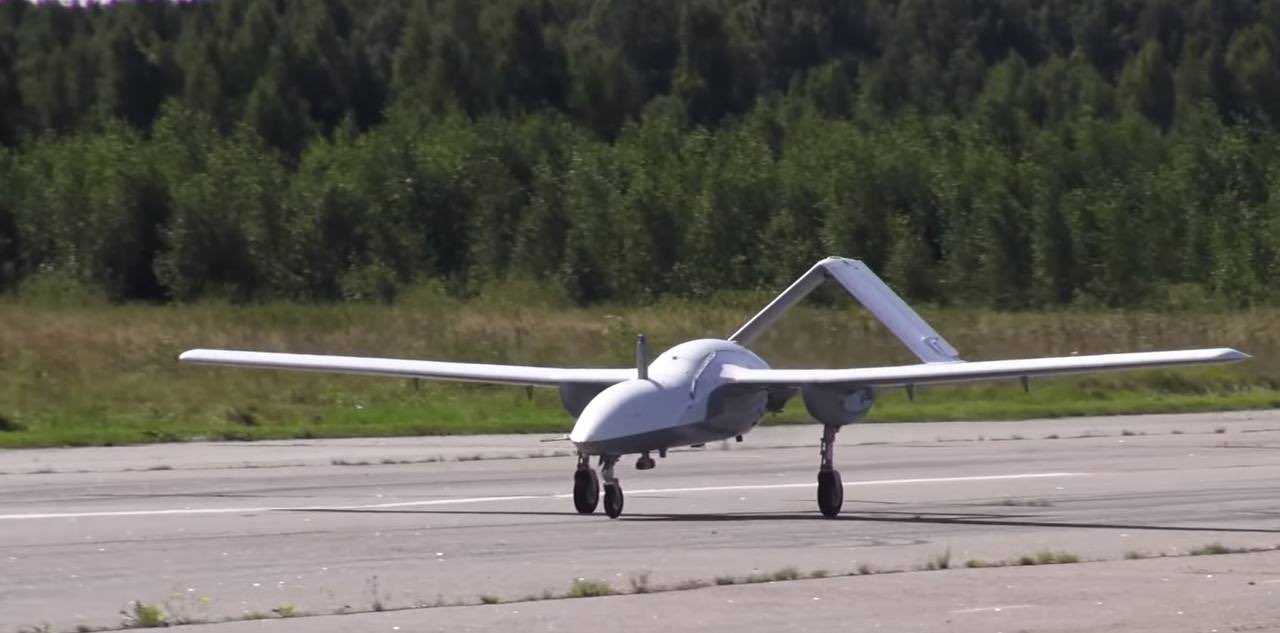Images of a destroyed Russian UAV resembling Turkish-made Bayraktar drones have surfaced online. The Russian drone is a rare UAV called the ‘Corsair’ or ‘Korsar,’ not to be confused with the Ukrainian Korsar Infantry Anti-Tank Guided Missiles (ATGMs).
The drone images were first shared by a Telegram channel, ‘Sofa Assault Brigade,‘ which reported that the Ukrainian armed forces shot down the drone. The drone looks very similar to the Turkish-made TB2 Bayraktar drones.

Corsair is a short- and medium-range reconnaissance UAV developed by KB Lutch, a research and development company based in Rybinsk, Yaroslavl Oblast, Russia, that calls itself a leader in the field of reconnaissance unmanned aerial vehicles and radio data link systems.
The development of Corsair was announced in 2009, and the first tests of the drone took place in 2015.
The Corsair UAV
The drone is made according to the traditional two-beam scheme with a pusher propeller and tail unit in the form of a reverse V. It is powered by a 50 hp piston engine that drives the pusher propeller.
Corsair can fly at a maximum speed of 150 kilometers per hour up to a range of 200 kilometers, with an endurance of 10 hours. Based on several reports, it has a maximum take-off weight of between 200-250 kilograms.
The UAV can perform take-off and landing in a standard way, but it can also be launched using a catapult without a runway. The launch is carried out from a unique launcher on the KAMAZ chassis. Several UAVs are placed in containers on the launcher at once.

Most importantly, the drone can reportedly fly at an altitude of around 5100 meters, remaining inaccessible to small arms and man-portable air defense systems.
This means there are three possibilities surrounding the circumstances of the Corsair that has allegedly been shot down: 1) the specifications provided by the Russian sources are inaccurate, or 2) the drone in question was flying below 4500 meters, or 3) the Ukrainian forces used medium and long-range air defenses, or maybe even a fighter aircraft to bring down the drone.
For surveillance, Corsair is equipped with a television and thermal imaging equipment.
The open architecture of the Corsair UAV system allows its capabilities to be adapted for various tasks, including weather reconnaissance, aerial photography, target search, and cargo transportation.

Also, the Corsair UAV uses the ‘All-Seeing Eye’ equipment, which allows processing hyperspectral data streams generated by the spectral radiation of each object or material to uniquely identify an object, regardless of the degree and type of disguise.
In addition to reconnaissance missions, the Corsair can carry out strikes using the ‘Ataka’ ATGMs or rocket-propelled grenades.
The Ataka series of ATGMs are designed to destroy modern tanks, infantry fighting vehicles (IFV), ATGM, surface-to-air missile (SAM) launchers, bunkers, low-flying and low-speed airborne targets, enemy personnel inside shelters, etc.
The Ataka ATGMs have three versions: the 9M120M, 9M120F, and 9M220O.

The 9M120M is armed with a tandem high-explosive anti-tank (HEAT) warhead. The 9M120F missile is armed with a high-explosive warhead designed to combat unarmored targets, which is incredibly destructive when it detonates in closed spaces such as bunkers and buildings.
The 9M220O is equipped with a fragmentation warhead and a proximity fuse capable of engaging an airborne target within a range of four meters.
Ukraine War Throws Spotlight On Several Rare Russian Drones
There are only three units of the Corsair, according to reports. This is probably because the drone was reportedly planned to be adopted by the Russian Army in 2025.
Since the start of the Ukraine war, several such rare and previously unknown Russian drones have come to light. For example, in June, an experimental Russian drone, Merlin-VR, was shot down by Ukrainian forces.
#Ukraine: An extremely rare Russian Merlin-VR unmanned aerial vehicle for the first time was shot down by Ukrainian forces. This is one of the most modern Russian reconnaissance drones with a payload of 6.5 kg and capable of flying at an altitude of up to 5 kilometers. pic.twitter.com/4CyllLD1gg
— ?? Ukraine Weapons Tracker (@UAWeapons) June 16, 2022
However, Russia’s most commonly used drones in its Special Military Operations in Ukraine have been the Orlan-10 and Zala Kyb Kamikaze drones.
In recent weeks, Russians have also been increasingly employing the Lancet family of drones for kamikaze attacks, and that too very effectively.
The Russian military campaign has relied mainly on Iranian-made drones for large-scale strikes across Ukraine. Before Iran supplied its drones to Russia, the Ukrainian military was winning the drone war.
- Contact the author at tanmaykadam700(at)gmail.com
- Follow EurAsian Times on Google News




